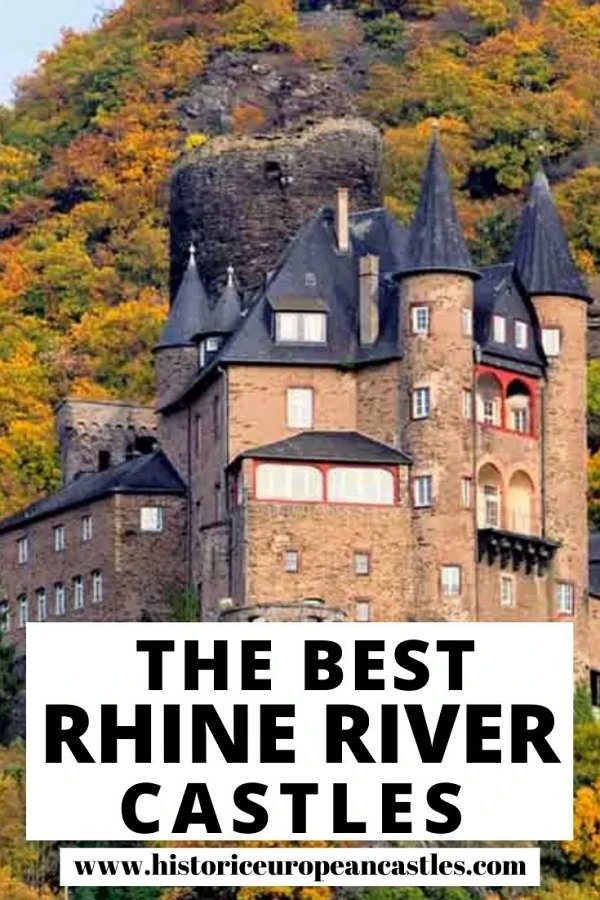The Rhine is Germany’s longest river by far, flowing for 690km. It is divided into the Alpine, High, Upper, Middle, and Lower Rhine, with hundreds of charming castles built overlooking and alongside its banks, many of them dating from the 12th-14th centuries with a fantastic mix of ruins and 19th century Romanticism makeovers.
The Upper Middle Rhine Valley is the most famous spot for seeing some of the best Rhine River Castles, with 40 strongholds, toll houses, and fairytale-like castles located amongst the grapevine valley that overlooks this 65km stretch of river.
A river cruise is the most popular way of seeing many of these picturesque castles in a day, but if you can plan a longer trip in the area, you really should go and explore the castles on foot, getting up close to the history of these places and the legends that go with them…
You can even spend the night as some of these historical castles, once strongholds and toll castles, are now hotels!
Disclaimer: This post contains affiliate links. This means that should you click on certain links and then subsequently purchase a product, I will receive a small commission.
Map of Rhine River Castles
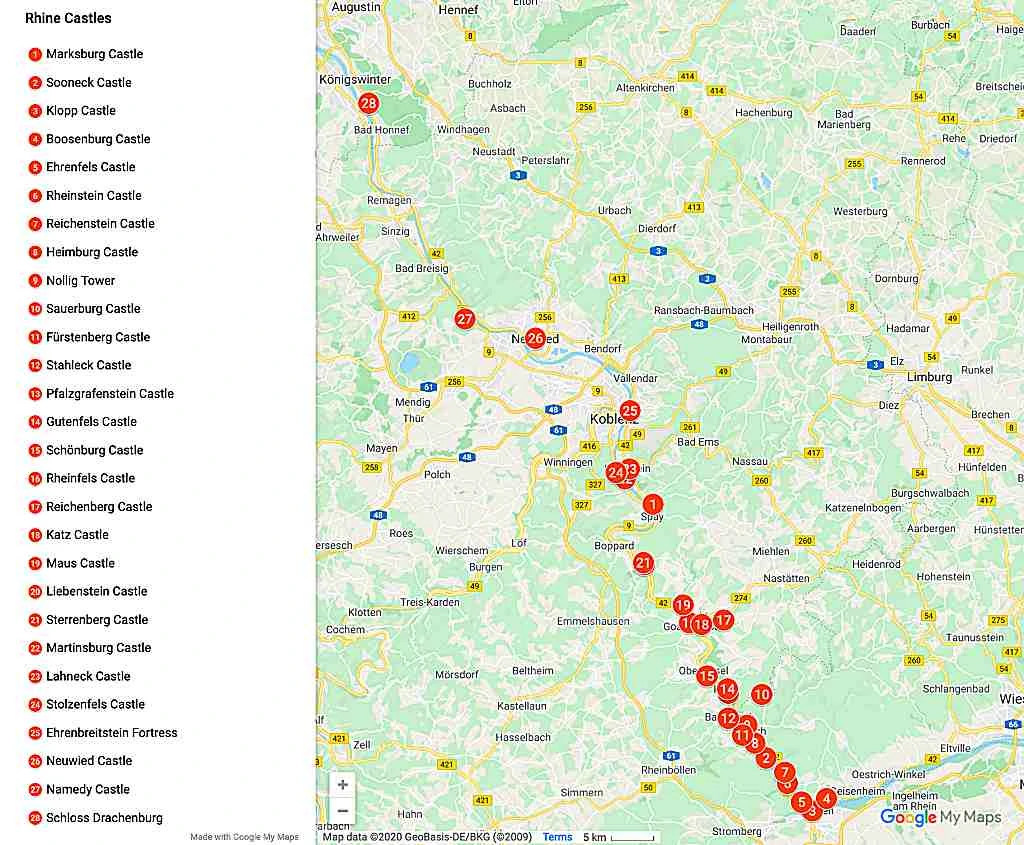
Where to Stay in the Rhine
There are many beautiful hotels in the Rhine where you can base yourself and book a rental car so you can explore this beautiful river region at your own pace.
Altkölnischer Hof: Located in Bacharach this traditional half-timbered hotel is the perfect place to explore the Rhine valley. With apartments and hotel rooms to choose from you can make the most of your stay. The on-site restaurant serves local cuisine including fish direct from the Rhine River. Book your stay here.
Romantik Hotel Schloss Rheinfels: Set at the foot of Rheinfels Castle and opposite the Loreley Rock, the views from this hotel are beautiful. You can take a boat trip on the river, swim in the hotel pool, and sample the 3 on-site restaurants, there is even a traditional German pub on the hotel grounds! Book your stay here.
Hotel Zur Kripp: A budget-friendly alternative is this hotel in Koblenz on the banks of the river. The rooms are bright and simply decorated with traditional wooden furniture. The hotel beer garden has views of the Lahneck, Marksburg, and Stolzenfels Castles. Book your stay here.
How to Get Around
The best way to visit the Rhine river castles is by car. There are two main roads following the Rhine on each riverside.
I recommend booking a car through Discover Cars, where you can compare all rental car agencies’ prices, and you can cancel or modify your booking for free. They also guarantee the best price. Click here for more information and to check the latest prices.
You can also book a romantic river cruise from Koblenz to enjoy the beautiful castles Marksburg, Lahneck, and Stolzenfels from the river Rhine. Click here for more information, availability, and the latest prices.
Alternatively, you can take the train to visit the Rhine river castles. The train, running along the left side of the Rhine, stops at every village and town, allowing you to see the castles or take in the breathtaking scenery. Click here for more information on train tickets.
28 Castles to Visit on the River Rhine
1. Marksburg Castle
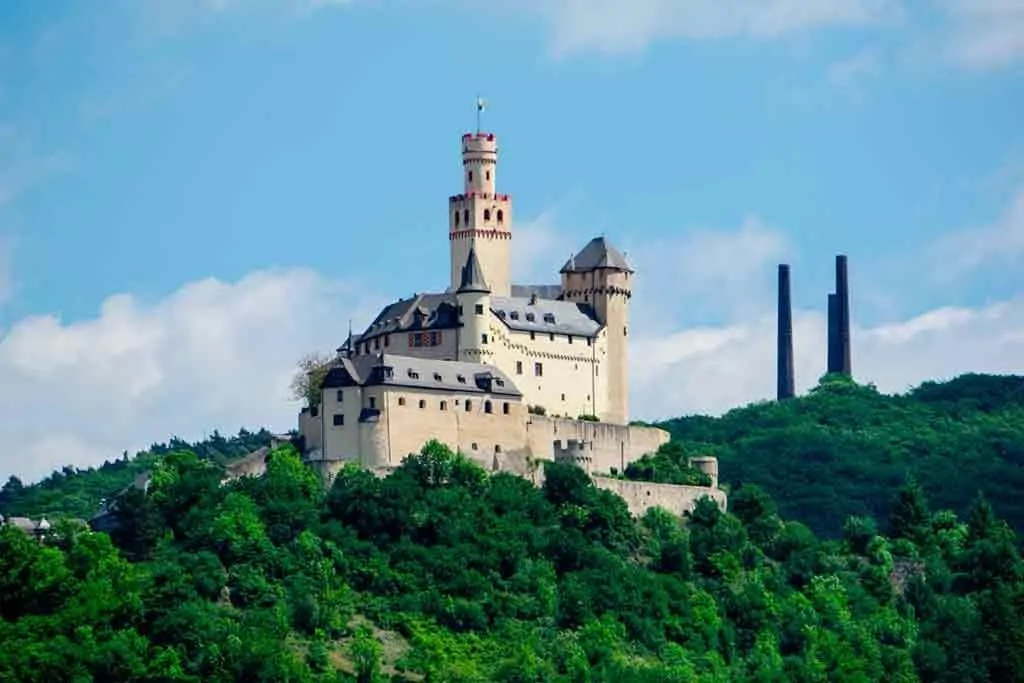
One of the most important castles in the Upper Middle Rhine Valley, this medieval stronghold is almost unchanged in appearance, having never been destroyed.
Visitors can take a 50-minute guided tour of the castle to see the kitchen, wine cellar, bed-chamber, great hall, armory, castle keep, and more as they step back in time to see what castle life was like in the Middle Ages.
Where: Braubach, Rhineland-Palatinate
When: 12th century
Style: Medieval
Open for visit: Yes. Click here for more information.
2. Sooneck Castle
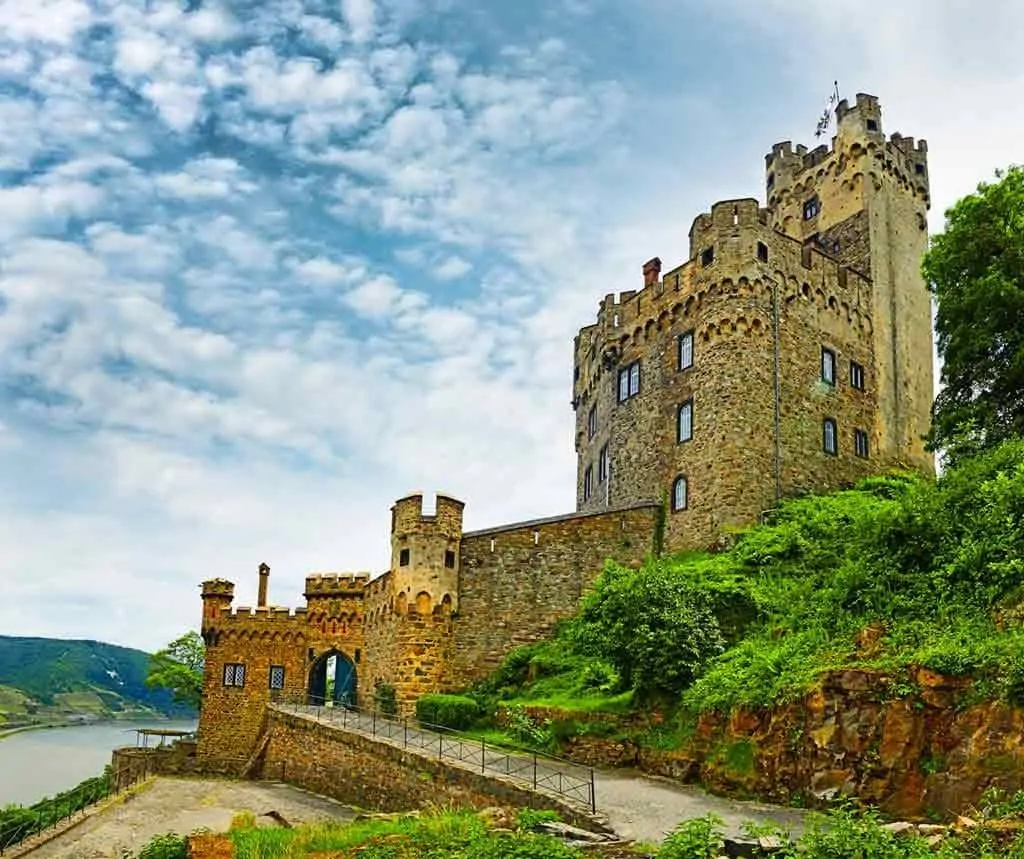
Named after the nearby Soon Forest, this castle was initially built for the abbey of Cornelimunster in the 11th century but was destroyed twice.
The first time was in 1282, being rebuilt in 1349 with the corner turrets, keep, and great hall that visitors can see today, and again in 1688, this time destroyed by the French troops of King Louis XIV.
In 1842 the castle was restored as a hunting lodge by the Prussian Royal Family though it was never actually used for this purpose. Today, visitors can step inside to admire the neo-gothic and Biedermeier-style interiors.
Where: Niederheimbach, Mainz-Bingen, Rhineland-Palatinate
When: 13th century
Style: Medieval
Open for visit: Yes, click here for more information.
3. Klopp Castle
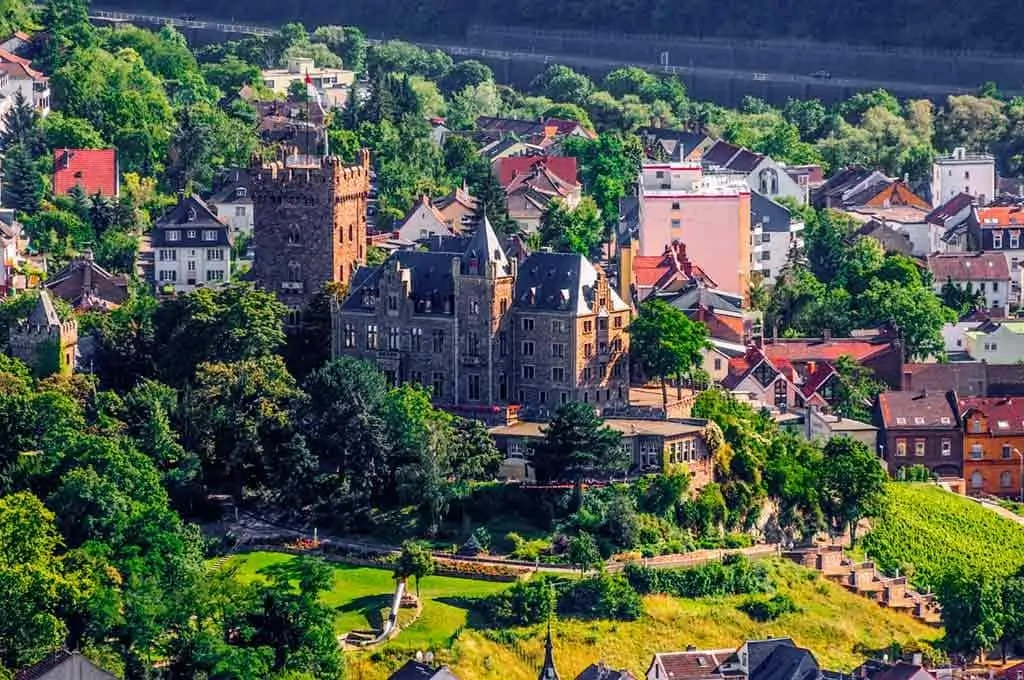
This hilltop castle has been built and destroyed numerous times throughout history, the first castle going back to Roman times. In the 12th century, it was used by the Archbishop of Mainz to collect tolls on the river but was destroyed in the Thirty Years War.
It was rebuilt in 1653 before it was destroyed again in the War of the Palatine Succession in 1689 and the War of the Spanish Succession in 1713. Much of what is seen today dates back to 1853, when restoration works took place for Ludwig Maria Cron.
Visitors can climb the tower and wander around the courtyard; the main part of the castle is closed to visitors as it houses the city council.
Where: Bingen am Rhein, Rhineland-Palatinate
When: 13th century / 19th century
Style: Medieval / Gothic
Open for visit: Yes, check here for more information.
4. Boosenburg Castle
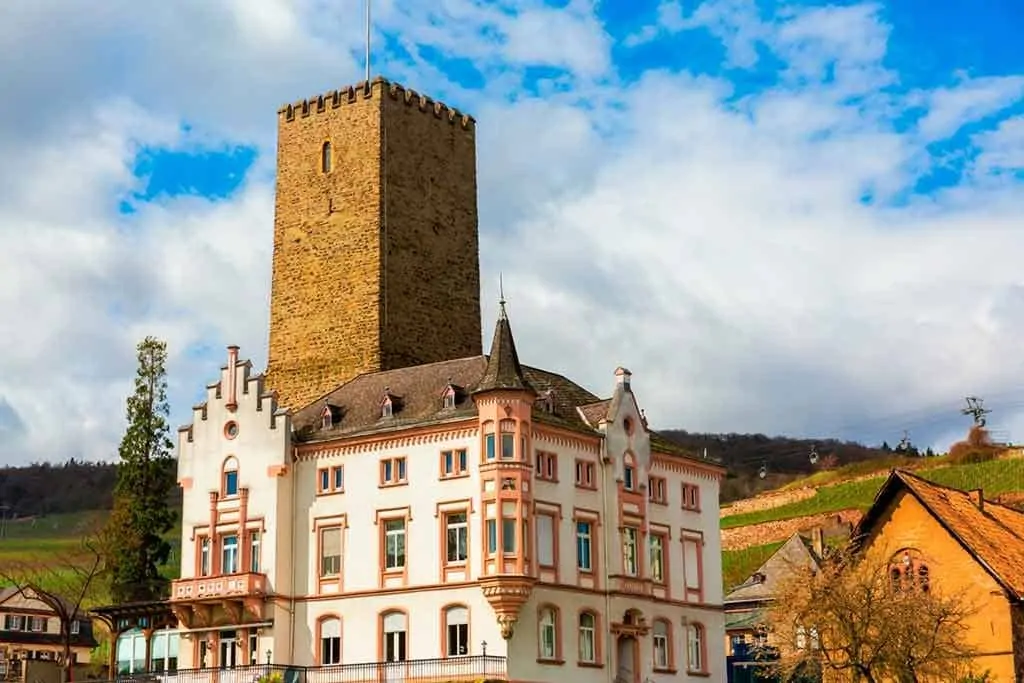
The 38-meter square tower of Boosenburg rises high above the residential palace-like building and vineyards below. As the tallest building in town, it’s an iconic sight and towers above the nearby Brömserburg castle.
The tower dates back to the 9th century and was owned by Boos von Waldeck in 1474. Privately owned today, it can only be admired from a distance.
Where: Rüdesheim am Rhein, Rheingau-Taunus-Kreis, Hesse
When: 12th century
Style: Romanesque
Open for visit: No
5. Ehrenfels Castle

This strategically built castle is located above the narrow entrance of the Binger Loch passage.
Fought over heavily during the Thirty Years War, Ehrenfels Castle became mighty when the Archbishop of Mainz took charge of it in approximately 1220, using the castle as part of his customs post (along with Mouse Castle) to extract money from passing river trade.
Once the post was moved, the castle was allowed to fall into ruin, finally destroyed in 1689 by fire and never restored.
Where: Rüdesheim am Rhein, Hesse
When: 13th century
Style: Romanesque
Open for visit: No
You might also like: Famous castles to visit in Germany.
6. Rheinstein Castle
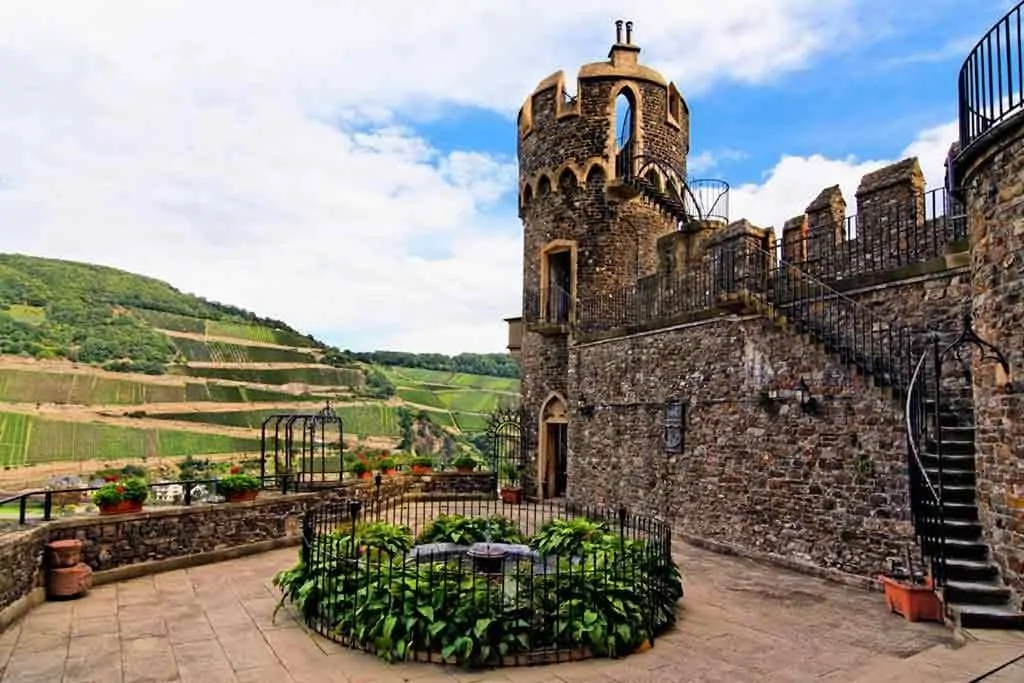
Built 270 feet above the River Rhine in the picturesque Loreley Valley, Rheinstein Castle was originally built as a customs post during the German Empire.
The iconic castle that is seen today, one of the most picturesque in the region, dates from 1823 and is complete with a working drawbridge and portcullis. Admire the surrounding views from the courtyard gardens where the Burgundy grapevine is grown before exploring inside the castle.
Where: Trechtingshausen, Rhineland-Palatinate
When: 10th century
Style: Medieval
Open for visit: Yes. Check here for more information.
7. Reichenstein Castle
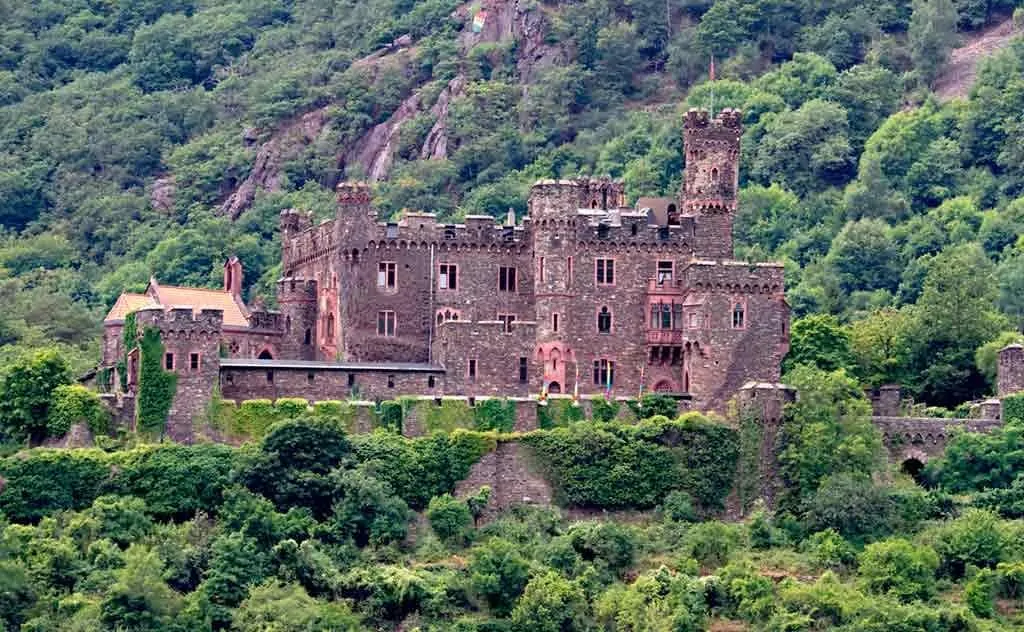
Also known as Falkenburg, this beautiful reconstructed medieval English-style castle started out as a stronghold and was owned by knights, bailiffs, and the church before becoming the home of the 19th-century Kirsch-Puricelli Barons.
Explore the castle interior admiring the private chambers, portrait gallery, library, and music room with Baroque statues, furniture from the times of Ludwig XV, and armor and weapons dating back to the era of Napoleon I.
Afterward, step outside to enjoy the Rhine views from the battlements walkway.
Where: Trechtingshausen, Rhineland-Palatinate
When: 11th century
Style: Neo-Gothic
Open for visit: Yes, check here for more information.
8. Heimburg Castle

Also known as Hohneck, this castle was first built in 1294 for Archbishop Gerhard von Eppstein (the archbishop of Mainz) as a defense against the Counts Palatine.
It had fallen into disrepair by the time Louis XIV’s troops came along and destroyed it in 1689. The castle seen today mostly dates from the 19th century when Hugo Stinnes rebuilt the castle to use as a Summer residence.
Where: Niederheimbach, Rhineland-Palatinate
When: 11th / 19th century
Style: Gothic
Open for visit: No, private property
9. Nollig Tower

This picturesque hilltop ruin, the remains of a large fortified square tower, stands above the town of the same name.
The tower originally formed part of the town fortifications, joined up to the city walls, and was built in the 1300s by the Nobles of Lorch, who used it as a watchtower known as Wachtenberg.
Where: Lorch, Rheingau-Taunus-Kreis Hesse
When: 14th century
Style: Medieval
Open for visit: No, private property
10. Sauerburg Castle
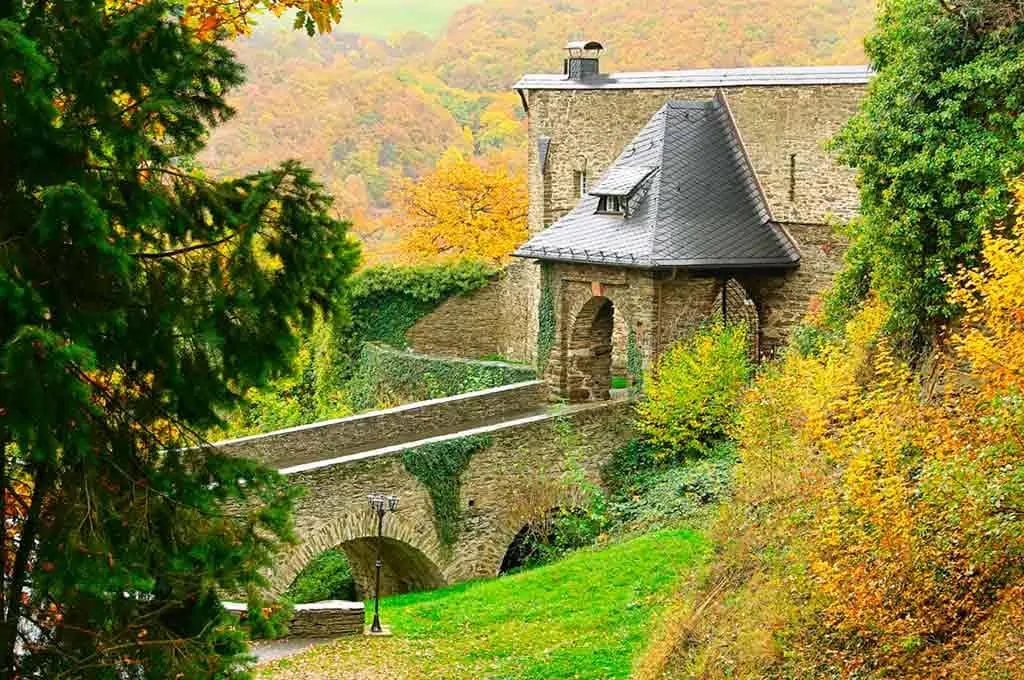
This breathtaking hilltop castle complex with an iconic ruined tower was built for Rupert I “the Red”, Count Palatine of the Rhine, in the mid to late 1350s on the approval of the Archbishop of Mainz.
It remained the property of the Palatine Counts until the 16th century, at which point it changed hands with several noble families until it was destroyed in 1689 by the troops of Louis XIV.
The castle remained in ruin until 1909 when restoration works began, and the castle is now being used as a hotel.
Where: Sauerthal, Rhineland-Palatinate
When: 14th century
Style: Medieval
Open for visit: For guests only.
11. Fürstenberg Castle

Otherwise known as the Kurkölnische Landesburg, which translates as the Electoral Cologne State Castle, this castle ruin with restored castle wall dates back to 1219 when it was founded by Engelbert I, the Archbishop of Cologne, who used the castle to levy tolls.
In 1314 the king of the Holy Roman Empire pledged Fürstenberg Castle to the Electorate of Mainz.
Under the sovereignty of three different electorates in the course of just one century, the castle was finally destroyed in the Palatine Wars of Succession and has remained in ruin ever since, save for the recently restored curtain wall.
Where: Rheindiebach, Rhineland-Palatinate
When: 13th century
Style: Medieval
Open for visit: No, privately owned
You might want to check out the best castles near Cologne.
12. Stahleck Castle

Boasting stunning views of the Rhine Valley from its terrace, this medieval castle has been used as a hostel since the 1920s but back in the 12th century, it secured the backbone of the Bacharach Empire together with neighboring Stahlberg Castle.
The home of Goswin von Höchstadt (Count of Stahleck) in 1135 Stahleck Castle, like many others, was destroyed some 500 years later in 1689 by Louis XIV’s army and lay in partial ruin until 1828 when the Crown Prince of Russia, Frederick William IV purchased it and began the job of restoring this castle to its former glory.
Where: Bacharach, Mainz-Bingen, Rhineland-Palatinate
When: 12th century
Style: Medieval
Open for visit: Interior access for guests only; non-guests can access the castle courtyard.
13. Pfalzgrafenstein Castle
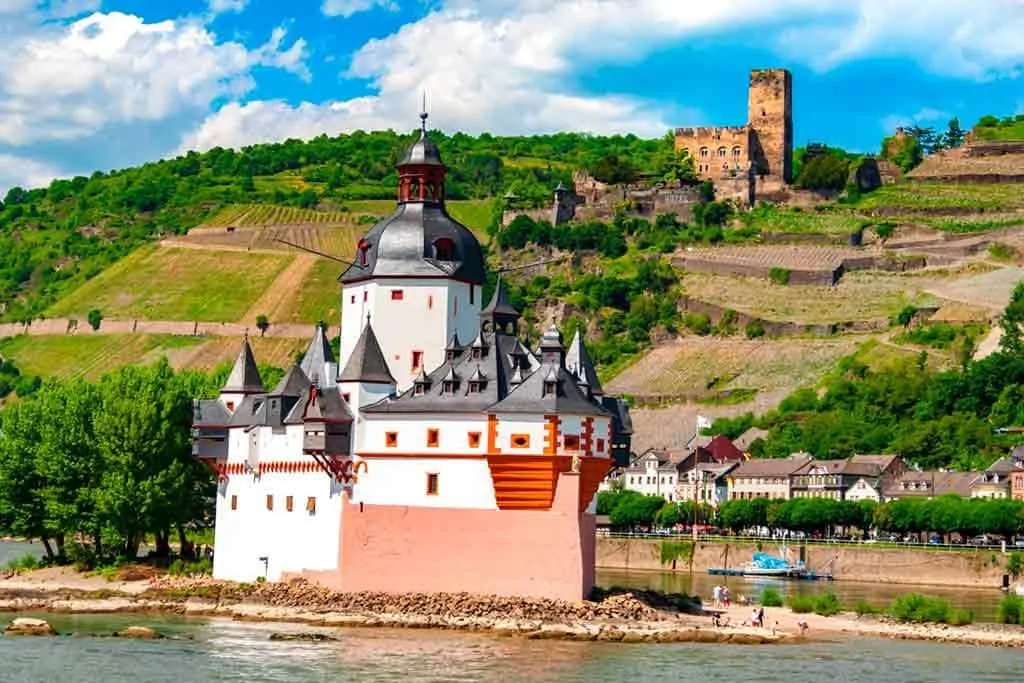
Built in the middle of the River Rhine on a tiny island called Falkenau, visitors can delight in the boat-shaped red and white castle known as Pfalzgrafenstein.
Built in an unusual pentagon shape reminiscent of a boat’s bow, this former stronghold, built by King Ludwig in 1326 with modifications in 1607 and 1755, was used as a toll station to extract money from passing river traffic.
Today visitors can enjoy a guided tour inside by a costumed guide, but they need to pre-book and ensure they time it right with the passing ferry service!
Where: Pfalz Island, Rhineland-Palatinate
When: 14th century
Style: Baroque
Open for visit: Guided tours by appointment only. Check here for more information.
14. Gutenfels Castle
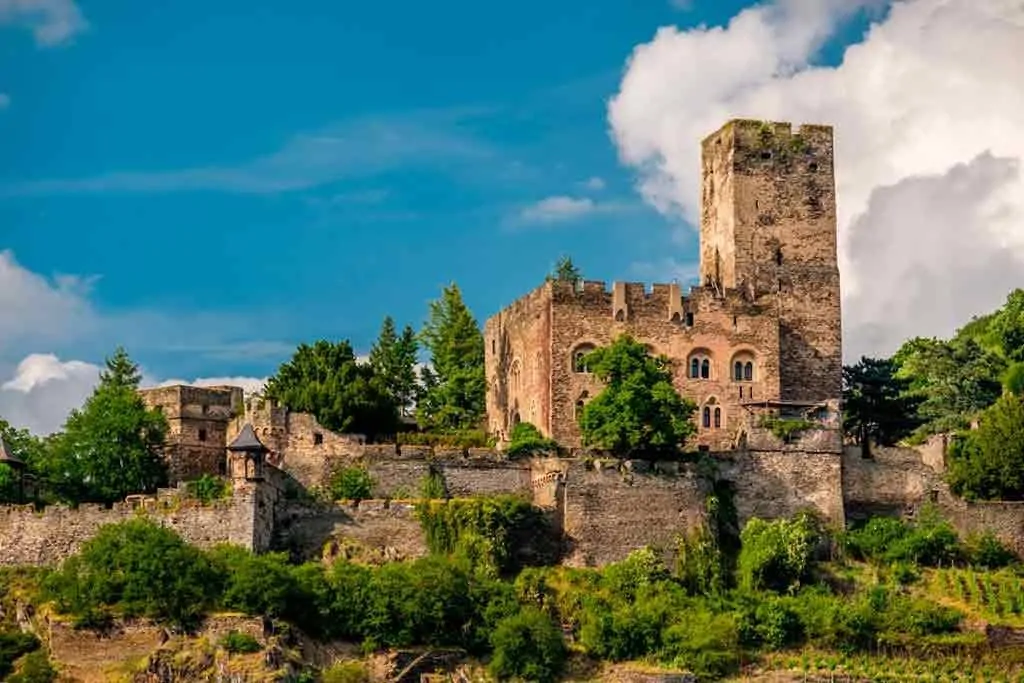
Also known as Caub or Kaub castle due to its location above the town, Gutenfels Castle was built in 1222 by the lords of Falkenstein-Münzenberg and used by the Holy Roman Emperor as a toll castle.
Together with Pfalzgrafenstein Castle, Gutenfels Castle created an impenetrable toll zone until 1866, when Prussia took over the area, the tolls ending the following year.
The castle has remained (for the most part) in the Falkenstein family since 1257 and has been a castle of the Electorate of Palatinate since 1277.
Where: Kaub, Rhineland-Palatinate
When: 13th / 19th century
Style: Medieval
Open for visit: By appointment only
15. Schönburg Castle

Thought to have been built for Count Palatine Hermann von Stahleck, Schönburg castle was later expanded by the Archbishops of Trier, who created the 20-meter high shield wall and zwingers so as to fortify the castle further.
It’s unique among the Rhine castles in that it remained in possession of the Empire until its destruction in 1689 by the troops of Louis XIV.
In 1885 the castle was purchased by Mr. Rhinelander, who restored the castle to its former glory; today, the castle itself contains a hotel though visitors can explore the 700-year-old history of the castle at the Gate Tower Museum.
Where: Oberwesel, Rhineland-Palatinate
When: 12th century
Style: Romanesque
Open for visit: Gate tower museum open Friday-Sunday 10 am-6 pm
16. Rheinfels Castle
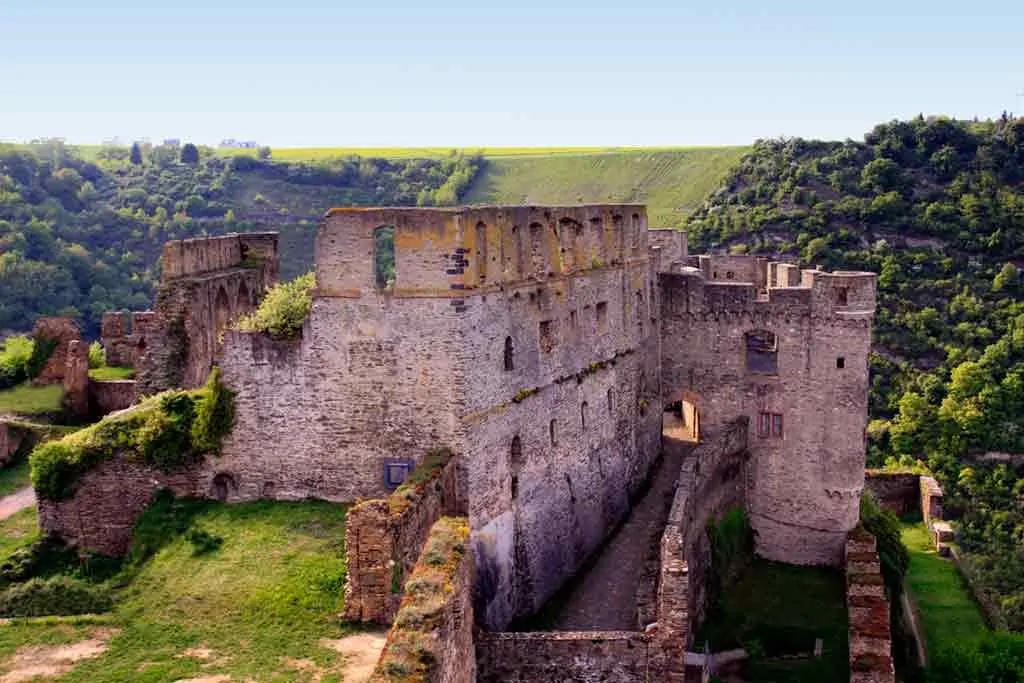
Founded in 1245 by Count Diether V of Katzenelnbogen, Rheinfels Castle grew to become the largest fortress in the Middle Rhein Valley, with the Counts of Katzenelnbogen and the House of Hesse making extensions to the castle, making it one of the strongest as well as the largest.
The castle withstood many sieges, including the attack from King Louis XIV’s troops in 1692. However, Rheinfels castle couldn’t withstand the attack by the French revolutionary army of 1794.
One of the most magnificent (and imposing) castle ruins on the Rhine today, visitors to Rheinfels Castle can wander through the castle rooms and climb spiral staircases to admire the views, as although the castle is missing its roof, much of the castle walls remain intact.
Where: St Goar, Rhineland-Palatinate
When: 13th – 18th century
Style: Medieval/Renaissance
Open for visit: Check here for more information.
17. Reichenberg Castle

Reichenberg Castle is one of the most unusual as well as important castle complexes in the whole of the Rhine Valley. Building work began in 1230 under the orders of Margrave Hermann V of Baden but the castle was never actually completed.
Despite this, it had unique design features for the time with its Mannerist shield wall, two unusually tall flanking towers measuring 43 meters high, and a hall with a ceiling built on cubiform capitals. The castle was abandoned in 1680, with the Northern tower collapsing just 40 years ago.
Where: Reichenberg, Rhein-Lahn, Rhineland-Palatinate
When: 13th century
Style: Medieval
Open for visit: No, private property
18. Katz Castle
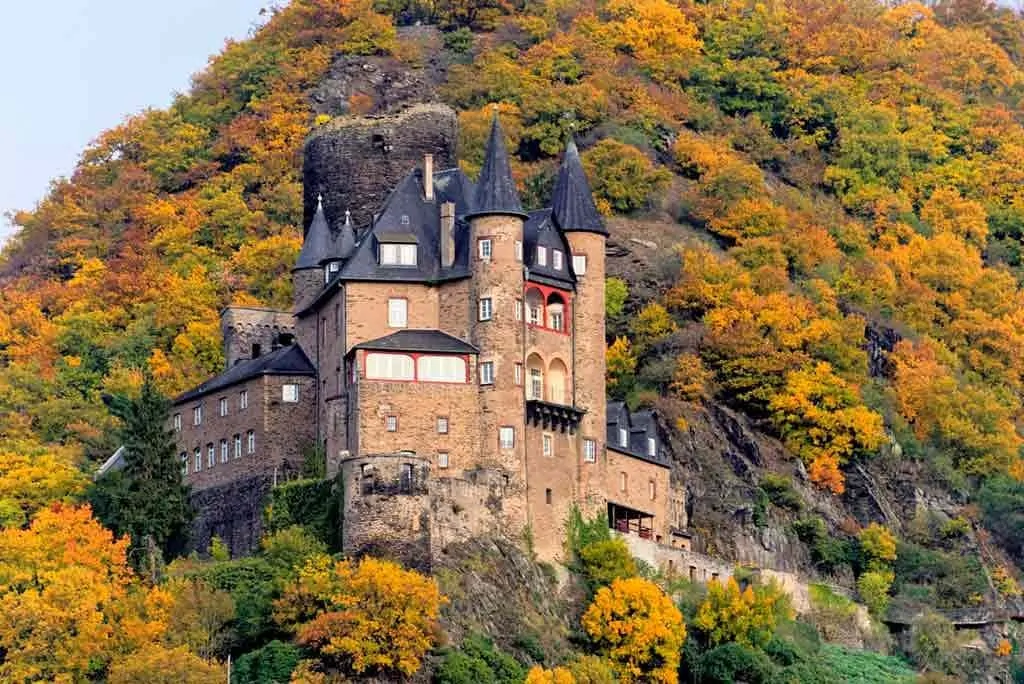
Known as Neukatzenelnbogen Castle when it was built, Katz Castle was built by Count Wilhelm II of Katzenelnbogen as a bastion and military base to protect nearby Rheinfels Castle, the two castles forming a fortified bulwark with a barrier for which to extract the Rhine toll.
Reinforced and upgraded to become a bastion against Maus Castle on the opposite bank, Katz Castle fell into dispute after the Counts of Katzenelnbogen family line died out in 1479.
This resulted in both Katz and Rheinfels Castles being besieged, demolished, and rebuilt several times, with Nalopean blowing up the Katz castle in 1806, just 6 years after it had been rebuilt.
In 1896 Katz Castle was reconstructed once more, following the original design, which allows visitors to admire the medieval castle today.
Where: St. Goarshausen, Rhineland-Palatinate
When: 14th century
Style: Medieval
Open for visit: For hotel guests only
19. Maus Castle

Otherwise known as Thurnberg Castle, this castle was built in the mid to late 1300s by Archbishop Balduin to protect his newly acquired territory and was the most modern castle of its time.
It became known as Maus (Mouse) Castle due to the building of Neukatzenelnbogen, aka Katz Castle, on the opposite banks of the river.
Visitors can take a guided tour around the interior of the castle to see the Knight’s Hall and other rooms, as well as watch the falcons, eagles, and owls at the on-site aviary with falconry displays during the Summer months.
Where: Wellmich, Rhineland-Palatinate
When: 14th century
Style: Medieval
Open for visit: Occasionally – Check website for details of guided tours.
20. Liebenstein Castle
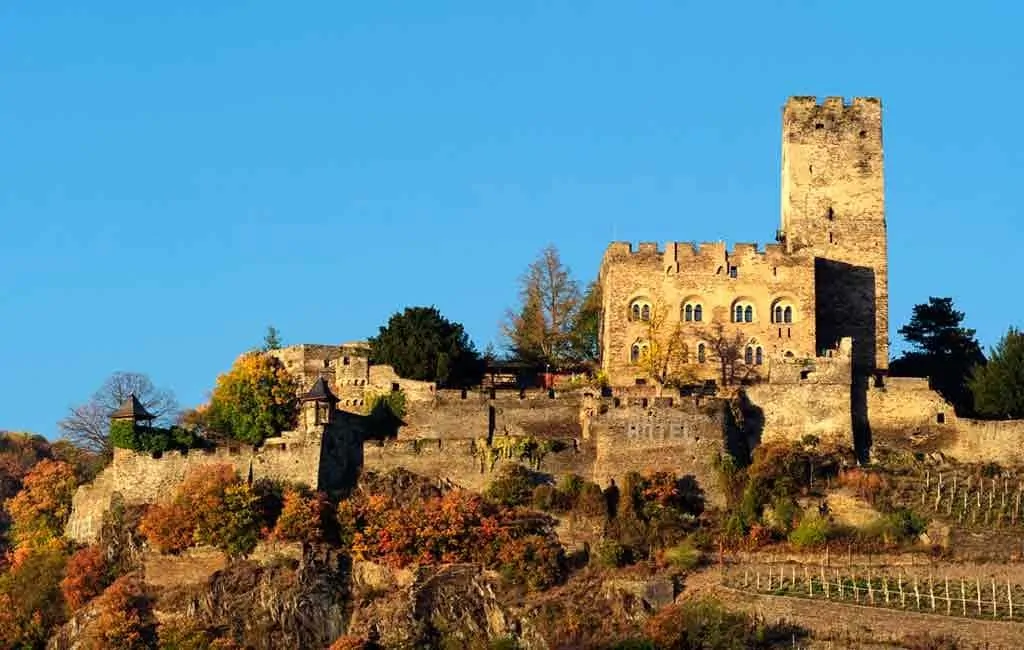
The highest castle in the Rhine Valley, Liebenstein Castle, together with Sterrenberg Castle, is known as the ‘Hostile Brothers’ due to the legend of two feuding brothers with castles next door to each other.
They fell in love with the same woman and ultimately became bitter enemies with just the high ‘Streitmauer’ wall separating the castles and the brothers.
A hotel today, visitors who stay at Libenstein Castle can learn the legend that tells of murder, lost love, and ghosts as they explore the supposedly haunted corridors for themselves!
Where: Kamp-Bornhofen, Rhineland-Palatinate
When: 13th century
Style: Medieval
Open for visit: Hotel guests only
21. Sterrenberg Castle

Otherwise known as ‘The White Castle,’ this is the other castle in the ‘Hostile Brothers’ castle legend, located next door to Liebenstein Castle.
Built in 1190, Sterrenberg Castle is one of the oldest Rhine Valley castles as well as one of the highest, yet by 1568 it was already a ruin. In the 1960s-70s, it was partially rebuilt in the Gothic style that we see today.
Where: Kamp-Bornhofen, Rhineland-Palatinate
When: 12th century
Style: Medieval/Gothic
Open for visit: Restaurant guests only.
22. Martinsburg Castle

This iconic castle with its hexagonal tower was originally used as a toll castle by the Electorate of Mainz, built at the same time as the city walls when the town was fortified.
Modified in the 18th century with wings added in the Gothic architectural style, it became a residential castle.
The original 14th-century tower still remains, yet it’s difficult to imagine the present building once being surrounded by a moat, this now being where the English-style garden is!
Where: Oberlahnstein, Lahnstein, Rhineland-Palatinate
When: 14th century
Style: Medieval / Gothic
Open for visit: May-September as part of a guided city tour only.
23. Lahneck Castle
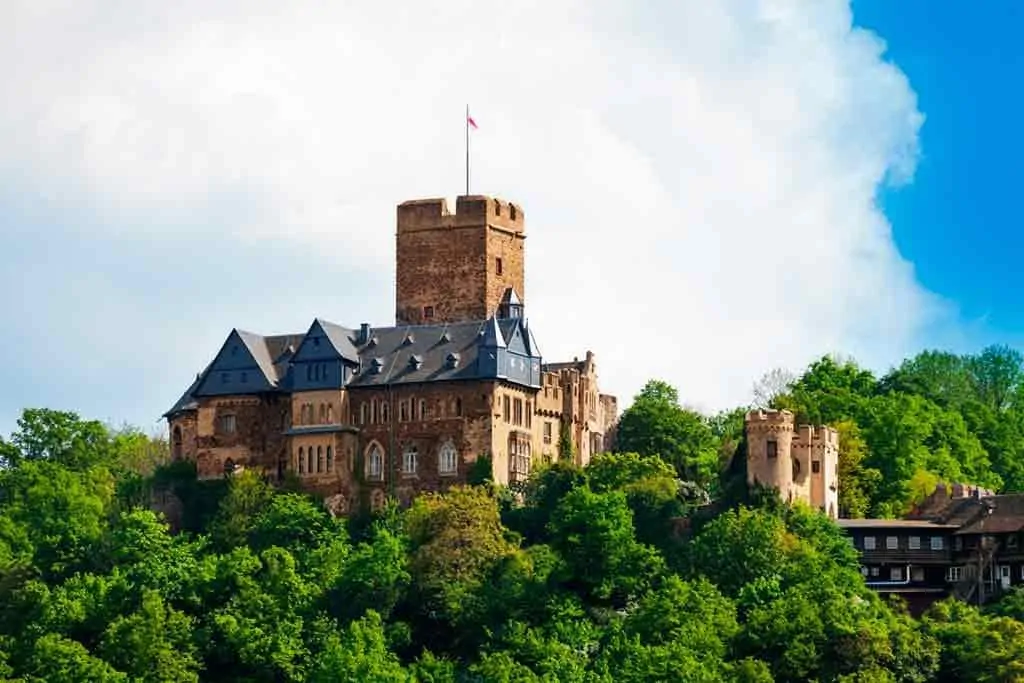
Built in 1244 overlooking the place where the River Lahn joins the Rhine Rhine, this strategically placed Medieval castle secured the silver mines as well as the border to the Archbishopric of Trier.
A mix of medieval, neo-Gothic, and 19th-century architecture, it’s a fine example of Rhine Romanticism. Take a guided tour to learn the history of Lahneck castle and its many legends as you walk around the great hall, chapel, and other rooms admiring the paintings, furniture, and armor.
Where: Lahnstein, Rhineland-Palatinate
When: 13th century
Style: Medieval/Neo-Gothic/Romanesque
Open for visit: Yes. Check here for more information.
24. Stolzenfels Castle
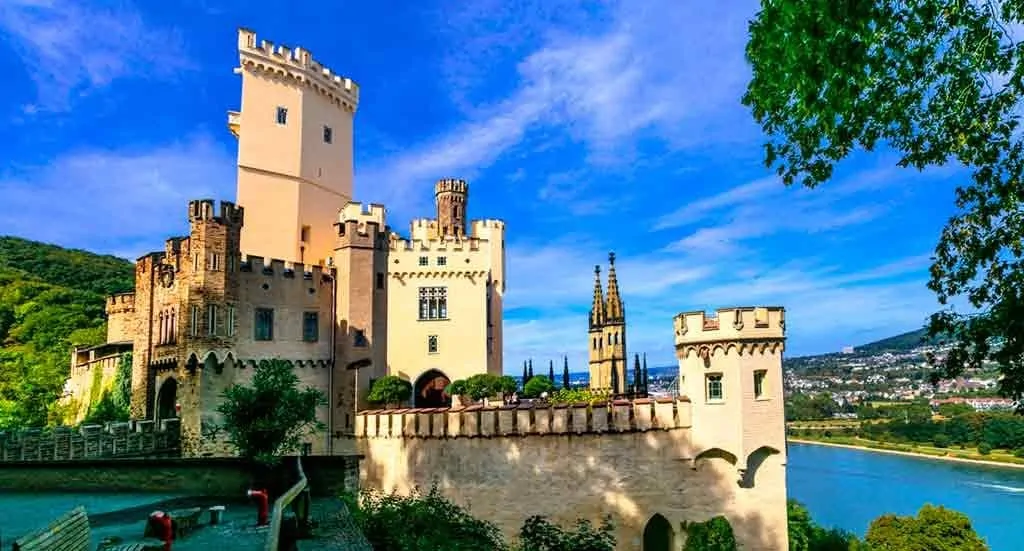
This magnificent UNESCO palace is a prime example of Prussian Rhine romanticism. Starting out as a Medieval fortress, built between 1242-1259 for The Trier Archbishop Arnold von Isenburg and used as a toll castle, it was destroyed in 1689 during the Palatine War of Succession.
The 19th-century building seen today was developed from the 13th-century ruins by Prussian Crown prince Frederick William who wanted a Summer residence.
Visitors can take a guided tour through the palace before exploring the five gardens plus landscaped park.
Where: Koblenz, Rhineland-Palatinate
When: 19th century
Style: Gothic Revival
Open for visit: Yes, check here for more information.
25. Ehrenbreitstein Fortress

This historical fortress is the 2nd largest preserved fortress in the whole of Europe and has a history dating back 1,000 years.
At one point, the fortress contained a castle, but the buildings seen today date from 1817-1828 and contain the Landesmuseum Koblenz, where visitors can learn about the archaeology and technical history of Germany as well as the history of the fortress.
Where: Koblenz, Rhineland-Palatinate
When: 19th century
Style: Classical
Open for visit: Yes, check here for more information.
26. Neuwied Castle

Originally built for Count Friedrich III zu Wied in 1648 as a bastion which was named Newen Wiedt, the original building was destroyed by French troops in 1694.
What we see today comes from the Count’s son, Count Friedrich Wilhelm, who had his French-style horseshoe-shaped castle (based on the design of Versailles) built between 1707-1711.
The two side wings were meant to join, to form the main building, but lack of funds meant the side wings were only joined and therefore completed in 1756.
Where: Neuwied, Rhineland-Palatinate
When: 17th century
Style: Classical
Open for visit: No, private property
27. Namedy Castle
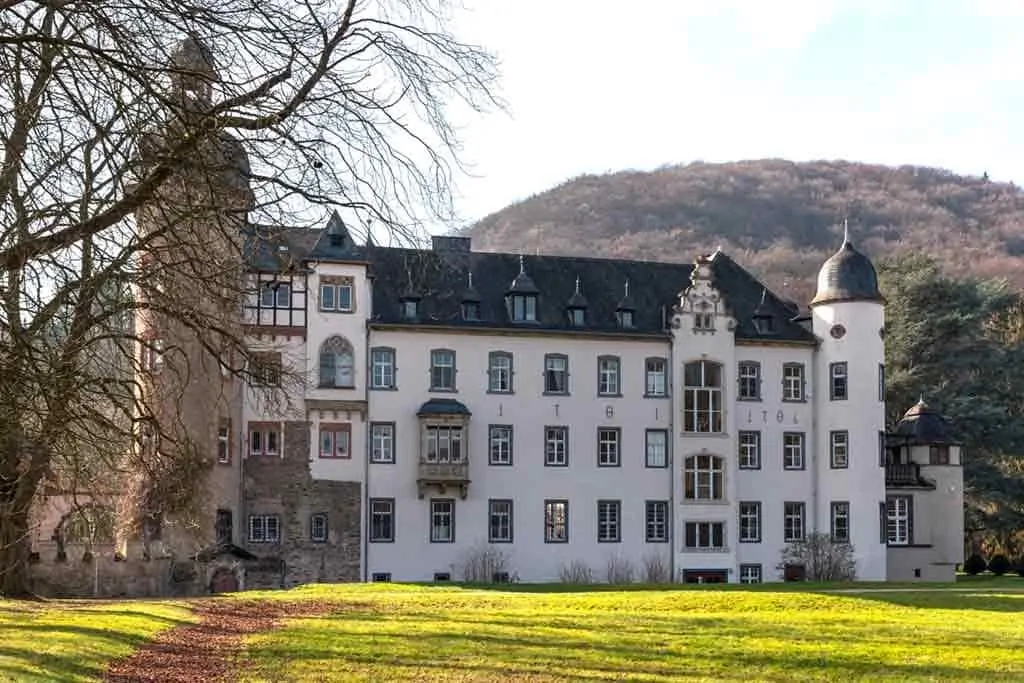
This beautiful fairytale-like castle with a medieval core was originally a moated castle founded by the Hausmann family in the 14th century, with 3 round towers added in the 16th century.
The original castle was destroyed in 1633 by Swedish troops, and a Baroque castle rebuilt on the site, which is what we can see today.
Where: Andernach, Mayen-Koblenz, Rhineland-Palatinate
When: 14th / 19th century
Style: Baroque
Open for visit: Only during events.
28. Schloss Drachenburg

Built in just two years from 1882, Drachenburg Castle was built as a private villa in a palace style for broker and banker Baron Stephan Sarter who planned to live at the fairytale-like castle but died before he was able to in 1902.
After his death, the castle has seen many uses; prior to WWI, it was a tourist attraction before being used as a Christian boarding school. In WWII, Drachenburg underwent a major change when it became the base for the Adolf Hitler School before being bombed and later used as a refugee camp.
Lying in near ruin for years, it was finally restored to its former glory in 1989, with the park restoration completed in 2011.
Where: Königswinter, Rhein-Sieg, North Rhine-Westphalia
When: 19th century
Style: Gothic Revival
Open for visit: Yes, check here for more information.
FAQs ABOUT THE RHINE RIVER CASTLES
Among the more than 40 castles along the Rhine Valley, the best castles are Stolzenfels Castle, Rheinfels Castle, Heidelberg Palace, Pfalzgrafenstein Castle, Marksburg, and Reichenstein Castle.
There are more than 40 castles along the Rhine river. Some of the castles are nowadays museums, have restaurants, or are luxurious hotels. You can take a river cruise to enjoy the breathtaking scenery and the Rhine castles.
Rheinfels Castle is the largest fortress in the Rhein Valley. The Counts of Katzenelnbogen and the House of Hesse turned it into the largest and mightiest castle. Today, visitors can walk around the castle ruins and enjoy the view of the Rhine river.
PIN IT!
